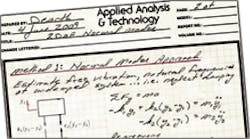David R. Dearth Resources: [email protected] or www.AppliedAnalysisAndTech.com Edited by Leslie Gordon |
Many readers probably think “black magic” describes the math involved in finding the dynamic response of a structure from random excitation. When can you be sure you have jumped through all the necessary “hoops and widgets” to generate a solution? Before you tackle advanced vibration analysis, it helps to know how to estimate resonant or natural vibration frequencies and plot animated mode shapes.
Confidence comes from practice. First solve sample problems with known solutions you can work through using hand calculations. In the case of simple static analysis or resonant-vibration problems, you can typically refer to “cookbook” equations in engineering text books to build sample FEA models.
Recall that free resonant-vibration problems necessitate obtaining the natural frequencies or eigenvalues of deformable bodies vibrating about the position of equilibrium and the associated mode shapes or eigenvectors. When damping is small, resonant-vibration frequencies are approximately equal to “free-vibration frequencies.” It can be useful to determine these frequencies to help estimate a design’s anticipated service life. Also, data from resonant-vibration analysis can provide the input for random vibration studies.
Under the hood, the FEA software produces a solution output file that consists of a table containing a certain set number of resonant-vibration frequencies, each of which has a corresponding mode shape. The software stores the mode shapes and their stresses as a series of “load cases” or “solution sets.” Animation routines found in most FEA software display the mode shapes as deflections at each particular resonant frequency.
Note that because resonant-vibration problems do not account for excitation, the magnitudes of the deflected shapes at this point are for reference only. The information is valid in the sense that it tells you how much some areas of the structure move relative to others, but the actual displacement values are still unknown.
After you perform the resonant-vibration analysis, the next step is to estimate how a structure responds to dynamic loading from vibration inputs. Dynamic loading is either harmonic or random. Harmonic vibration subjects the structure to input loading, gs, at specific sinusoidal frequencies; for example, 2-gs base excitation at 115 Hz. Random vibration, on the other hand, excites all resonant frequencies simultaneously over a bandwidth range, say 5 to 2,000 Hz. Input excitation levels are typically defined in terms of power-spectral density (PSD) curves over a range of frequencies.
Some FEA software performs random analysis by essentially “shaking” the entire model as though it is fastened at its support points to a shaker table. Sometime this approach is referred to as “base excitation.” To determine the response at explicit points in the structure with regions other than support points attached to the shaker, it is necessary to use comprehensive analysis codes such as MSC.Nastran.
The random-analysis software searches the table of resonant-vibration frequencies for those that match the inputs. When the software finds free-vibration frequencies that match or closely match the input frequency, it computes the response or amplification caused by the external excitation.
For harmonic inputs, the software processes the FEA model using an external excitation force at the resonant frequency associated with the deflected-mode shape shown on the computer screen. This approach quantifies the precise magnitude of displacements and stresses at a particular resonant-vibration frequency to an external excitation.
Random-vibration analyses define external loading in terms of PSD inputs (g2) as a function of frequency. The units for the input, g2/Hz, cover the bandwidth of interest. The software calculates an overall root-mean-squared average, depending on the level of participation each resonant mode plays on the structure’s response. The magnitude of the displacements and stresses now take on a realistic meaning. In fact, both random and harmonic analyses provide results that correlate closely to those of physical tests.
The know-how to perform dynamic-vibration analyses also comes from the process of hand calculating sample problems. The sample problems should let you check results against a known theoretical solution. Keep in mind that the hoops and widgets you jump through to solve even the simplest FEA models are the same ones you will encounter when solving real problems using a computer. The only difference is usually the complexity of the geometry.
There are generally three ways to address dynamic responses to finite-element models (FEMs) from random excitation. The direct approach provides the most exact solution but it proves logistically difficult to manage for most software. The normal modes method suits large, complex, multidegree of freedom systems (>100 DOFs) that are typically analyzed using FEA techniques. This approach introduces a transformation of coordinate approximations to decouple the differential equations of motion and make the problem easier to solve.
The Mile’s Equation approach involves FEA models of large complicated systems that contain an excessively large number of DOFs. The approach is based on statistical analyses of induced acceleration spectra with a three-sigma distribution. The software computes an equivalent g loading using the PSD criteria at the resonant frequency in each orthogonal direction of interest. This equivalent g load is sometimes referred to as the random-vibration load factor (RVLF).
